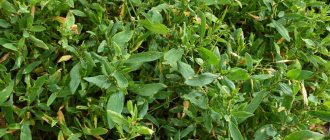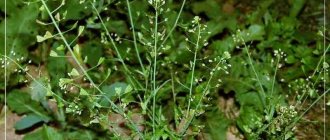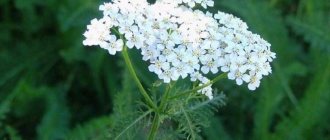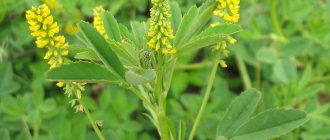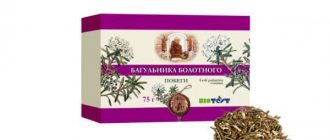The article was prepared by a specialist for informational purposes only. We urge you not to self-medicate. When the first symptoms appear, consult a doctor.
Thermopsis is a foul-smelling perennial plant with long creeping rhizomes and a simple, erect stem. This herbaceous plant has trifoliate, grayish-green, lanceolate-shaped leaves. The leaf blades are supplemented with large stipules. Large yellow flowers of irregular shape are collected in graceful clusters. The thermopsis fruit is a linear bean with a small spout.
This unique plant blooms in June and July. Around August, the seeds begin to ripen. Thermopsis is found in the Volga region and in the steppe regions of southwestern Russia. It prefers saline damp meadows, grassy slopes, fields and steppes.
Useful properties of thermopsis
The presented herb contains large quantities of substances useful to humans, esters and alkaloids. Various preparations based on thermopsis have a powerful expectorant effect. The tannins and saponins contained in the grass have quite diverse effects on the human body. Such a plant can increase blood pressure, stimulate appetite, increase the tone of the uterus and inhibit the nodes of the autonomic nervous system. Thanks to anagarine, the herb has curare-like properties.
In modern medical practice, various preparations containing thermopsis are used as an expectorant and anti-inflammatory agent for various colds and infectious diseases. Healing infusions of the herb promote rapid removal of mucus from the respiratory tract, stimulate breathing and relieve spasms of peripheral blood vessels. In addition, thermopsis is indicated for hypotension, as well as for stimulating weak labor. The powder of this dry plant produces an insecticidal effect.
Herbs such as thermopsis have been proven to be effective as an anthelmintic. Modern doctors prescribe the herb not only for pneumonia and bronchitis, but also for fever, flu, headaches and intestinal atony.
Application of thermopsis
All kinds of herbal infusions and decoctions have a pronounced stimulating effect on the removal of phlegm. It is manifested by increased secretory functions of the bronchial glands, accelerated evacuation of secretions and increased activity of the smallest ciliated epithelium, as well as increased smooth muscle tone due to the vagotropic effect.
Thermopsis is indicated for both adults and children. It is no coincidence that it is part of many complex medicinal teas and herbal mixtures. For chronic bronchitis and pneumonia, it is difficult to do without such a universal remedy. To prepare an infusion of 6 mg of herb, take one glass of boiling water and infuse the product for about eight hours. Adults should take it up to 5 times a day, 1 tablespoon. The children's dosage is 1 tablespoon no more than three times a day.
Thermopsis preparations are often prescribed for low blood pressure; at the same time, due to special adrenergic mechanisms of action, they also enhance the function of the adrenal glands. It should also be noted that the plant has ganglion-blocking properties. When prescribing medicinal preparations based on thermopsis, it is recommended to be careful, since thermopsis is considered a potent substance.
Thermopsis for cough
Popular cough tablets based on thermopsis have been successfully used for decades, despite the availability of more modern medications. This wonderful expectorant is indicated for various ailments of the bronchopulmonary system.
When taken orally, these tablets are absorbed in the gastrointestinal tract itself, and then instantly enter the bloodstream and the mucous membrane of the trachea and bronchi, producing a powerful irritating effect. This causes reflex secretion of thick bronchial secretions. The motor activity of the bronchial muscles also increases, which promotes expectoration and complete removal of pathogenic sputum.
Thanks to the sodium bicarbonate included in the tablets, they significantly reduce the viscosity of sputum. Thermopsis is indicated for non-productive dry cough.
How to take thermopsis? For bronchitis and pneumonia, as well as for acute inflammatory diseases of the respiratory tract, adults are prescribed to take the medicine 3 times a day, one whole tablet. The course of treatment should be at least three days. For prolonged or chronic inflammation, the course is extended to 5 days.
Thermopsis for cough for children. Up to two years of age, it is recommended to give children an infusion of herbs, which is prepared at the rate of 0.1 grams of raw material per 100 ml of boiling water. The medicine should be taken half a teaspoon no more than three times a day. For children under 6 years old, you can increase the dose of infusion to 1 teaspoon. Children from 6 to 12 years old are prescribed a course of treatment of 0.5 tablets. To get results, you should take the medicine regularly for at least three days.
Chemical composition and mechanism of toxic action
From 0.5 to 3.6% of the total mass of thermopsis contains alkaloids: thermospin, cytisine, pachycarpine, anagyrine, homothermospin. Tannic, resinous and mucous components, essential oil, saponins, vitamin C, thermopsilancin - a glycoside of flavonoid origin.
Taking thermopsis preparations, preparing raw materials and other manipulations must take into account that these substances are very toxic. These drugs should be excluded from the list of drugs for patients suffering from cardiovascular insufficiency.
And work with these raw materials should also exclude the work of such patients. And in healthy people, the influence of raw materials can lead to an allergic reaction. Itching of the skin of the body and face may occur, swelling and changes in the mucous membranes may appear. A rash will appear within 48 hours of illness.
A similar reaction can occur with unauthorized use and with long-term courses of taking thermopsis. Anagyrine, from Thermopsis, can have an effect similar to that of nicotine and block the transmission of stimulation of the autonomic ganglia and neurointestinal endings.
Self-collection of raw materials is not recommended
The storage conditions of the drugs do not have any distinct features. Storage temperature should not be higher than 25ºС. The storage room must be dry. Layout areas must be protected from direct sunlight on storage objects.
At home, medications should be stored in places that under no circumstances can be accessible to children.
The drug has a maximum shelf life of 5 years from the date of manufacture, which is indicated on the packaging. If the expiration date has expired, the drug must be discarded.
Picture of poisoning
When eating grass and seeds, poisoning occurs. Cyanosis, paresis of the limbs, and cardiac dysfunction are noted. A failure in the functioning of the cardiac system can lead to collapse, which, together with asphyxia, causes death.
Main symptoms
Main symptoms: excessive salivation, nausea, severe vomiting. At the height of poisoning, diarrhea occurs. In case of severe poisoning, clouding of consciousness, agitation, and hallucinations are possible. Breathing quickens at first, and then is suppressed until it stops completely. Convulsions are observed, which are replaced by depression.
Increasing respiratory distress together with cardiovascular failure can lead to death
First aid
The first step is gastric lavage through a tube combined with a saline laxative. Tannin through a probe. For convulsions, chloral hydrate in an enema, barbamyl intramuscularly. Excessive excitation is extinguished by intramuscular injection of aminazip.
For weakness of the heart muscle - strophantip. Atropine in the initial stage of poisoning, 1-3 ml of a 0.1% solution under the skin, will give positive results.
Thermopsis infusion
Thermopsis infusion is known for its expectorant properties. In large dosages, it often leads to a gag reflex. By increasing the secretion of mucus in the respiratory airways, it significantly increases the own contractility of the bronchi. Stimulation of smooth muscles ensures the removal of phlegm. Along with this, thermopsis infusion increases blood pressure. It is worth mentioning the strong ganglion-blocking properties of the presented drug.
To independently prepare the presented herbal infusion, you will need at least 200 grams of water per 1 gram of dried herb. It is recommended to infuse the product for about 40–50 minutes, and then strain. The dosage for an adult should not exceed 1 tablespoon; you can drink the drug up to 4 times a day.
Thermopsis lanceolata
Thermopsis lanceolata is an unusual herbaceous plant, the height of which varies from 10 to 45 cm. The presented perennial has long creeping roots and thin, few roots. Straight, few-branched stems have light grooves and pubescence before flowering. The trifoliate alternate leaves are on the petioles. Their elliptical shape and solid edge make the leaf blades elegant. Young leaves are always densely pubescent and folded.
The thin apical raceme represents the inflorescence. The flowers are located on short stalks in the axils of the bracts. The small bean, about 5 cm long, has a linear, protruding seed receptacle. When the fruit valves open, kidney-shaped, smooth seeds with a bluish-black coating appear. Lanceolate thermopsis blooms in June and early July. This species can be found in Siberia and Kazakhstan. As a rule, this plant chooses saline and sandy soils. It settles in river valleys, on small gravelly slopes, and also in wheat crops.
Botanical description of the plant
Lanceolate thermopsis (in Latin - Termopsis Lanceolata), belongs to the legume family. The plant is perennial, with a long creeping rhizome, up to 40 centimeters high. The stem is ribbed to the touch and covered with hairs.
The content of the article
- Botanical description of the plant
- Chemical composition of the plant
- Medicinal properties and uses
- Medical preparations from thermopsis
- Possible harm, contraindications, side effects
The leaves are alternate, trifoliate, linear-oblong, pubescent with white hairs. Up to 7 cm long and up to 1.5 cm wide.
And the flowers are yellow, large, like moths, collected in a raceme inflorescence. Apical sours grow up to 17 cm long. The flowers are arranged oppositely or collected in whorls. Perianth or bract up to 2 cm long. The yellow corolla is up to 3 cm long; at the end of flowering it forms a fruit - a bean up to 9 cm in length. Inside the bean, up to 14 seeds (peas), up to 4 mm in diameter, black in color, develop.
The plant is a weed, considered in many places to be a difficult to eradicate weed. But its large yellow flowers delight the eye and decorate the surrounding steppe landscape. Thermopsis blooms in June - July.
This is a typical steppe plant, familiar to everyone who lives in Eastern and Western Siberia.
Spreading . Under natural conditions, it also grows in the Tien Shan Mountains, Kyrgyzstan and Kazakhstan. In the European region of our country it is found in the Volga region. Loves sunny meadows with sandy soils, chooses dry gentle slopes. It can grow in crops like a weed.
Walking to the dacha, I saw a yellow meadow of brightly blooming thermopsis on the outskirts of the city, next to the forest. Bright yellow spots were visible from a distance. Look at the photo, how beautiful it is - a poisonous weed, Thermopsis lanceolata.
Harvesting grass, drying raw materials
Like many poisonous plants, thermopsis is a healing plant. The entire grass with flowers, leaves and seeds is harvested from thermopsis. The grass is collected during flowering, cutting off the stem 3-4 centimeters above the root collar.
Thermopsis should be dried immediately after cutting, in a well-ventilated area, under a canopy or in the attic. Dry in dryers at temperatures up to 60 degrees.
The seeds are collected from September, the beans are threshed, aerated and dried, just like the grass. When drying grass and seeds, care must be taken, since thermopsis is a poisonous plant. The shelf life of raw materials is up to two years.
Contraindications to the use of thermopsis
The main contraindications to the use of this plant include hypersensitivity and ulcerative conditions of the stomach and duodenum. In case of overdose, vomiting may occur.
Author of the article:
Sokolova Nina Vladimirovna |
Herbalist Education: Diploma in General Medicine and Therapy received from the University named after N.I. Pirogov (2005 and 2006). Advanced training at the Department of Herbal Medicine at the Moscow People's Friendship University (2008). Our authors
Side effects
The use of thermopsis may be accompanied by side effects: nausea, vomiting, itching of the skin. Overdose may cause dizziness, headache, vomiting and drowsiness. In case of overdose, it is necessary to immediately stop taking it and perform gastric lavage.
Restrictions for taking the drug are: hypersensitivity to the components of the drug, peptic ulcer of the stomach and duodenum in the acute phase, children under 12 years of age, pregnancy during breastfeeding.
It is not recommended to prescribe the drug for pulmonary diseases accompanied by hemoptysis.
Poisonous organs
Any plant, including medicinal ones, has its own characteristics. Some parts of the plant are medicinal, while others have a higher content of useful or useless substances.
Thermopsis grass is one of the poisonous plants. The seeds of this plant contain the highest concentration of toxic substances
